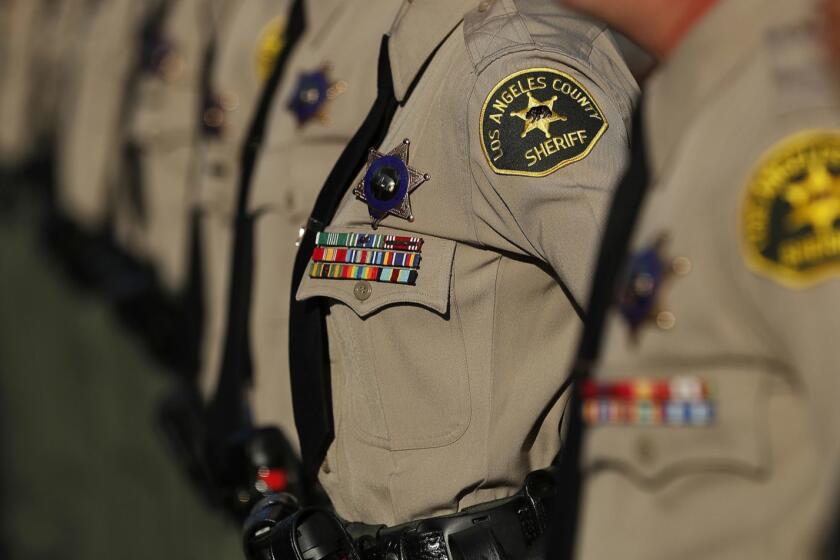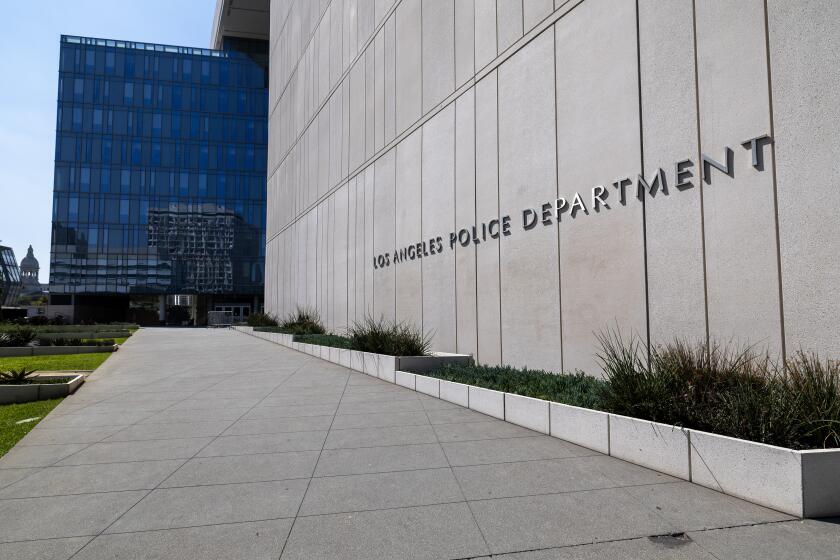Preaching Politics
- Share via
Sixteen miles from where the Roman Catholic Archdiocese of Los Angeles is building its grand downtown cathedral, Pastor Isaac J. Canales stands in a converted Carson warehouse shouting godly exhortations to his Pentecostal flock. Upstretched arms and open palms sway back and forth in the pews, beckoning the Holy Spirit to break over them like a cresting wave and sweep them to a new spiritual shore in the Promised Land. “O, Gloria a Dios!” a Latina murmurs. “Amen. Hallelujah!” a man rejoins.
The holy words spew from Canales’ mouth with a raspy edge, then quiet to a whisper. He plants an elbow on the edge of the pulpit and leans forward. His manner is confidential, almost covert, as if to impart a secret. His multicultural flock listens intently, perhaps seeing themselves or someone they know in his accounts of powerlessness, arrests, troubled marriages and illnesses. Others had faced seemingly insurmountable obstacles, he tells them, and with God’s help, prevailed. He directs their attention to a passage in their opened Bibles, 2 Kings 6:15-17. Elisha’s servant awakened one morning to find their city surrounded by an army with horses and chariots. “Do not be afraid,” Elisha counseled, “for there are more with us than there are with them.”
For most of the 20th century, the scene at Mission Eben-Ezer Family Church has offered intimations of the kingdom, but not the power--at least not the earthly power and privilege enjoyed by Southern California’s influential synagogues and big steeple churches. Outlying congregations, especially Pentecostal and evangelical churches filled by ethnic minorities, were relegated to the fringes. Devoid of political power because their congregants were powerless, they busied themselves with the sweet by and by. They knew the poor in spirit would someday see the kingdom of heaven, and that someday the meek would inherit the earth. Now that earthly someday may be here.
Academics, urban ministry experts and members of the clergy who follow such trends say that a radical shift of religious influence and power is underway, with churches like Canales’ on the cutting edge. Centralized, hierarchical leadership as personified by Cardinal Roger M. Mahony will be matched by a diffused, decentralized, cooperative leadership. Believers who have hesitated to venture into the secular city will engage in political action. They will come to embrace an aphorism long appreciated in African American churches: “There’s a danger in us becoming so spiritual that we’re of no earthly good.”
Canales’ church may seem a far cry from the influence and power represented by the new Cathedral of Our Lady of the Angels, scheduled to open in 2001. The $163-million edifice will be the mother church of the nation’s largest archdiocese, and its location alone bespeaks ecclesiastical clout. It is being built on a hill three blocks from City Hall, across Temple Street from the seat of Los Angeles County government and virtually next door to the Music Center and planned Walt Disney Concert Hall, both heavily endowed by Southern California’s corporate and philanthropic powers.
Soon, however, neighborhood churches, synagogues and mosques also will have political say. Grass-roots activism will shape electoral politics and public policy. “If one looks at leadership in the new millennium, one must also look at the neighborhoods, because that’s where the new Los Angeles is being created,” says John Orr, director of research for the Center for Religion and Civic Culture at USC.
In years past, a liberal coalition of high-profile rabbis, ministers and bishops could speak in the name of Southern California’s most populous faith communities. The old liberal coalition joined hands in the 1960s in the cause of the black civil rights struggle. Their moral outrage and the fact that they spoke from prominent pulpits translated into political power. But it will take more in the next century than a title and signature to move mountains. In fact, it already does. Michael A. Mata, director of the Urban Leadership Institute at the Claremont School of Theology, recounts the reaction people often have now when he presents them with petitions signed by a church bigwig: “Big deal.” They are more impressed with people who have some grasp of the issue at hand, he says.
Canales, who earned his master’s of divinity from the Harvard University Divinity School and a doctorate in New Testament from Fuller Theological Seminary in Pasadena, puts it more colorfully. “A third great awakening is on the way,” he says, referring to the two 18th century revivals that swept through the American colonies. “It gives me chills even to speak about it. I can feel it. I can see it personally from my window and from the pulpit in the community, a new secularization of the Gospel spirit. Faith is coming out of the city. Faith is emerging from the streets. It’s not emerging from cathedrals. Faith is emerging, percolating up from the asphalt, oozing out of the little storefront and warehouses [churches], people talking about it at work, Bible studies at high school, cells at colleges, home Bible groups. The spirit’s moving in a different way.”
A few big-name figures, including the Rev. Cecil “Chip” Murray, senior pastor of First African Methodist Episcopal Church in Los Angeles, may sustain influence. His church, and the predominantly white All Saints Episcopal Church in Pasadena, will likely remain powerhouses committed to political action. But big mainline churches face hard going in Christianity’s second millennium.
“People want to keep a straight face because they don’t want to start a run on the bank. But the church is in trouble across the board,” says the Rev. Eugene Williams, executive director of the 5-year-old Los Angeles Metropolitan Churches, a group of 45 small- to medium-sized African American congregations that is exerting major political influence, most recently by backing legislation to require that juvenile parolees work toward high school equivalency diplomas. “The struggle is now for relevance,” says Williams. Many issues in the future, he says, will be more effectively addressed by contacting neighborhood leaders who are “closer to the ground” than by calling someone like Mahony.
This expansion of influence also means that Asian Christians and Buddhists, as well as Muslims of all ethnic groups, will gain influence in the 21st century. Immigration and birth rates are boosting these groups’ numbers, upwardly mobile second- and third-generation members are assimilating into the mainstream, and people are recognizing that in a place as culturally diverse as Southern California, no single religious interest group can accomplish its economic and political goals without reaching out. Already, the Hsi Lai Buddhist Temple in Hacienda Heights has helped flood victims in Central America. Holy Hill Community Church, a Korean Presbyterian congregation near Chinatown, has sent its young people to Mexico and joined with Chinese American merchants to clean up streets in Chinatown. In Carson, members of Canales’ congregation campaigned for better lighting at a local high school.
In Los Angeles, where voters have approved a new city charter that empowers local districts through neighborhood councils, faith communities have an opening for greater political participation. No organizations have more “branch offices” in neighborhoods than churches, synagogues and mosques. “They’re already established,” Mata says. “They will have a greater role.”
As they take up causes that require political action as well as prayer, Latino Protestants, particularly Pentecostals, will gain the most urban throw weight. In 1993 a coalition of 13 churches in Pico Rivera, led by the Rev. Richard Ochoa of the Lord’s Vineyard Fellowship, opposed the city’s plans to permit a gambling casino. And this year, a group of Latino evangelicals joined a campaign to fight gay-rights legislation in Sacramento.
So far, few of the more than 1,300 religiously affiliated nonprofit corporations in Los Angeles that run food, job training, low-cost housing and other social services have involved Pentecostal or evangelical churches. But as participation increases, so will the exercise of power, not just at the local level but also in Sacramento and Washington.
“If we don’t speak up on issues of moral concern, who will?” the Rev. Samuel Sanchez, superintendent of Assemblies of God churches in Southern California, said at the time.
There are about 230 Spanish-speaking Assemblies of God churches in Southern California alone. That denomination has established 25 new Spanish-speaking churches a year from the Mexican border to Ventura--and that is just one easily tracked major denomination. It’s much harder to count the surge in independent storefront Latino evangelical and Pentecostal churches. It is on this new religious playing field that a tug-of-war for power (and, perhaps, more cooperation) will take place. Part of the reason for evangelical church growth, after all, is that large numbers of Latinos are leaving the Catholic church. The 1990 National Survey of Religious Identification, conducted by the City University of New York, identified about 66% of U.S. Hispanics as Catholic. But a 1998 survey by the National Opinion Research Center found that 1 in 10 Latino Catholics leave the church each year. Those who join another church usually opt for an evangelical or Pentecostal congregation rather than a mainline Protestant church. “It’s more like a family,” says Larry Loy, 37, a former Catholic who began attending Canales’ church in Carson. “Catholics are Christian, too. I don’t see nothing wrong with it. But you go in and don’t meet no one. You pray and leave.”
Numbers alone are not enough to assure any group power. Social class and other factors also play a role. “There is not going to be a straight-line correlation between the rise of Latino power and decreasing power of other populations, as if size were the only consideration,” says professor Miller.
“The power base is growing with all of them,” says Grace Dyrness, associate director of USC’s religion and civic culture center. “They are getting involved more and want to have an influence on what happens in their city.”
Most see the emergence of new leaders as a good thing. “It’s not enough for us to have one shining light that offers vision and mission,” says the Rev. Mark Whitlock of Christ Our Redeemer African Methodist Episcopal Church in Irvine and a key figure in neighborhood economic development. “God offers multiple lights to move through his vision for a brighter future, where we all benefit.”
More to Read
Sign up for Essential California
The most important California stories and recommendations in your inbox every morning.
You may occasionally receive promotional content from the Los Angeles Times.













